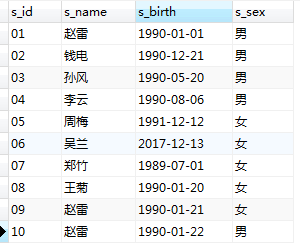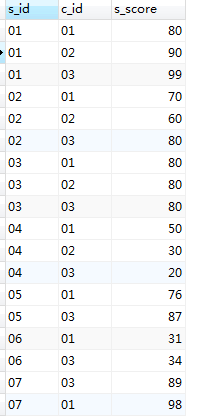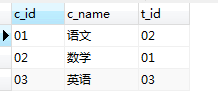sql语句练习50题(Mysql版) 围观
表名和字段
- –.学生表
- Student(s_id,s_name,s_birth,s_sex) –学生编号,学生姓名, 出生年月,学生性别
- –.课程表
- Course(c_id,c_name,t_id) – –课程编号, 课程名称, 教师编号
- –.教师表
- Teacher(t_id,t_name) –教师编号,教师姓名
- –.成绩表
- Score(s_id,c_id,s_score) –学生编号,课程编号,分数
测试数据
- --建表
- --学生表
- CREATE TABLE `Student`(
- `s_id` VARCHAR(20),
- `s_name` VARCHAR(20) NOT NULL DEFAULT '',
- `s_birth` VARCHAR(20) NOT NULL DEFAULT '',
- `s_sex` VARCHAR(10) NOT NULL DEFAULT '',
- PRIMARY KEY(`s_id`)
- );
- --课程表
- CREATE TABLE `Course`(
- `c_id` VARCHAR(20),
- `c_name` VARCHAR(20) NOT NULL DEFAULT '',
- `t_id` VARCHAR(20) NOT NULL,
- PRIMARY KEY(`c_id`)
- );
- --教师表
- CREATE TABLE `Teacher`(
- `t_id` VARCHAR(20),
- `t_name` VARCHAR(20) NOT NULL DEFAULT '',
- PRIMARY KEY(`t_id`)
- );
- --成绩表
- CREATE TABLE `Score`(
- `s_id` VARCHAR(20),
- `c_id` VARCHAR(20),
- `s_score` INT(3),
- PRIMARY KEY(`s_id`,`c_id`)
- );
- --插入学生表测试数据
- insert into Student values('' , '赵雷' , '1990-01-01' , '男');
- insert into Student values('' , '钱电' , '1990-12-21' , '男');
- insert into Student values('' , '孙风' , '1990-05-20' , '男');
- insert into Student values('' , '李云' , '1990-08-06' , '男');
- insert into Student values('' , '周梅' , '1991-12-01' , '女');
- insert into Student values('' , '吴兰' , '1992-03-01' , '女');
- insert into Student values('' , '郑竹' , '1989-07-01' , '女');
- insert into Student values('' , '王菊' , '1990-01-20' , '女');
- --课程表测试数据
- insert into Course values('' , '语文' , '');
- insert into Course values('' , '数学' , '');
- insert into Course values('' , '英语' , '');
- --教师表测试数据
- insert into Teacher values('' , '张三');
- insert into Teacher values('' , '李四');
- insert into Teacher values('' , '王五');
- --成绩表测试数据
- insert into Score values('' , '' , 80);
- insert into Score values('' , '' , 90);
- insert into Score values('' , '' , 99);
- insert into Score values('' , '' , 70);
- insert into Score values('' , '' , 60);
- insert into Score values('' , '' , 80);
- insert into Score values('' , '' , 80);
- insert into Score values('' , '' , 80);
- insert into Score values('' , '' , 80);
- insert into Score values('' , '' , 50);
- insert into Score values('' , '' , 30);
- insert into Score values('' , '' , 20);
- insert into Score values('' , '' , 76);
- insert into Score values('' , '' , 87);
- insert into Score values('' , '' , 31);
- insert into Score values('' , '' , 34);
- insert into Score values('' , '' , 89);
- insert into Score values('' , '' , 98);
表数据如下:




- -- 准备条件,去掉 sql_mode 的 ONLY_FULL_GROUP_BY 否则此种情况下会报错:
- -- Expression #1 of select list is not in group by clause and contains nonaggregated column 'userinfo.
- -- 原因:
- -- MySQL 5.7.5和up实现了对功能依赖的检测。如果启用了only_full_group_by SQL模式(在默认情况下是这样),
- -- 那么MySQL就会拒绝选择列表、条件或顺序列表引用的查询,这些查询将引用组中未命名的非聚合列,而不是在功能上依赖于它们。
- -- (在5.7.5之前,MySQL没有检测到功能依赖项,only_full_group_by在默认情况下是不启用的。关于前5.7.5行为的描述,请参阅MySQL 5.6参考手册。)
- -- 执行以下个命令,可以查看 sql_mode 的内容。
- SHOW SESSION VARIABLES;
- SHOW GLOBAL VARIABLES;
- select @@sql_mode;
- -- 更改
- set global sql_mode='STRICT_TRANS_TABLES,NO_ZERO_IN_DATE,NO_ZERO_DATE,ERROR_FOR_DIVISION_BY_ZERO,NO_AUTO_CREATE_USER,NO_ENGINE_SUBSTITUTION';
- set session sql_mode='STRICT_TRANS_TABLES,NO_ZERO_IN_DATE,NO_ZERO_DATE,ERROR_FOR_DIVISION_BY_ZERO,NO_AUTO_CREATE_USER,NO_ENGINE_SUBSTITUTION';
练习题和sql语句
- -- 1、查询"01"课程比"02"课程成绩高的学生的信息及课程分数
- select st.*,sc.s_score as '语文' ,sc2.s_score '数学'
- from student st
- left join score sc on sc.s_id=st.s_id and sc.c_id=''
- left join score sc2 on sc2.s_id=st.s_id and sc2.c_id=''
- where sc.s_score>sc2.s_score
- -- 2、查询"01"课程比"02"课程成绩低的学生的信息及课程分数
- select st.*,sc.s_score '语文',sc2.s_score '数学' from student st
- left join score sc on sc.s_id=st.s_id and sc.c_id=''
- left join score sc2 on sc2.s_id=st.s_id and sc2.c_id=''
- where sc.s_score<sc2.s_score
- -- 3、查询平均成绩大于等于60分的同学的学生编号和学生姓名和平均成绩
- select st.s_id,st.s_name,ROUND(AVG(sc.s_score),2) "平均成绩" from student st
- left join score sc on sc.s_id=st.s_id
- group by st.s_id having AVG(sc.s_score)>=60
- -- 4、查询平均成绩小于60分的同学的学生编号和学生姓名和平均成绩
- -- (包括有成绩的和无成绩的)
- select st.s_id,st.s_name,(case when ROUND(AVG(sc.s_score),2) is null then 0 else ROUND(AVG(sc.s_score),2) end ) "平均成绩" from student st
- left join score sc on sc.s_id=st.s_id
- group by st.s_id having AVG(sc.s_score)<60 or AVG(sc.s_score) is NULL
- -- 5、查询所有同学的学生编号、学生姓名、选课总数、所有课程的总成绩
- select st.s_id,st.s_name,count(sc.c_id) "选课总数",sum(case when sc.s_score is null then 0 else sc.s_score end) "总成绩"
- from student st
- left join score sc on st.s_id = sc.s_id
- group by st.s_id
- -- 6、查询"李"姓老师的数量
- select t.t_name,count(t.t_id) from teacher t
- group by t.t_id having t.t_name like "李%";
- -- 7、查询学过"张三"老师授课的同学的信息
- select st.* from student st
- left join score sc on sc.s_id=st.s_id
- left join course c on c.c_id=sc.c_id
- left join teacher t on t.t_id=c.t_id
- where t.t_name="张三"
- -- 8、查询没学过"张三"老师授课的同学的信息
- -- 张三老师教的课
- select c.* from course c left join teacher t on t.t_id=c.t_id where t.t_name="张三"
- -- 有张三老师课成绩的st.s_id
- select sc.s_id from score sc where sc.c_id in (select c.c_id from course c left join teacher t on t.t_id=c.t_id where t.t_name="张三")
- -- 不在上面查到的st.s_id的学生信息,即没学过张三老师授课的同学信息
- select st.* from student st where st.s_id not in(
- select sc.s_id from score sc where sc.c_id in (select c.c_id from course c left join teacher t on t.t_id=c.t_id where t.t_name="张三")
- )
- -- 9、查询学过编号为"01"并且也学过编号为"02"的课程的同学的信息
- select st.* from student st
- inner join score sc on sc.s_id = st.s_id
- inner join course c on c.c_id=sc.c_id and c.c_id="01"
- where st.s_id in (
- select st2.s_id from student st2
- inner join score sc2 on sc2.s_id = st2.s_id
- inner join course c2 on c2.c_id=sc2.c_id and c2.c_id="02"
- )
- select a.*
- from
- student a,
- score b,
- score c
- where
- a.s_id = b.s_id
- and a.s_id = c.s_id
- and b.c_id = ''
- and c.c_id = '';
- -- 10、查询学过编号为"01"但是没有学过编号为"02"的课程的同学的信息
- select st.* from student st
- inner join score sc on sc.s_id = st.s_id
- inner join course c on c.c_id=sc.c_id and c.c_id="01"
- where st.s_id not in (
- select st2.s_id from student st2
- inner join score sc2 on sc2.s_id = st2.s_id
- inner join course c2 on c2.c_id=sc2.c_id and c2.c_id="02"
- )
- -- 11、查询没有学全所有课程的同学的信息
- select * from student where s_id not in (
- select st.s_id from student st
- inner join score sc on sc.s_id = st.s_id and sc.c_id="01"
- where st.s_id in (
- select st1.s_id from student st1
- inner join score sc2 on sc2.s_id = st1.s_id and sc2.c_id="02"
- ) and st.s_id in (
- select st2.s_id from student st2
- inner join score sc2 on sc2.s_id = st2.s_id and sc2.c_id="03"
- ))
- select a.*
- from student a
- left join score b on a.s_id = b.s_id
- group by
- a.s_id
- having
- count(b.c_id) != '';
- -- 12、查询至少有一门课与学号为"01"的同学所学相同的同学的信息
- select distinct st.* from student st
- left join score sc on sc.s_id=st.s_id
- where sc.c_id in (
- select sc2.c_id from student st2
- left join score sc2 on sc2.s_id=st2.s_id
- where st2.s_id =''
- )
- -- 13、查询和"01"号的同学学习的课程完全相同的其他同学的信息
- select st.* from student st
- left join score sc on sc.s_id=st.s_id
- group by st.s_id
- having group_concat(sc.c_id) =
- (
- select group_concat(sc2.c_id) from student st2
- left join score sc2 on sc2.s_id=st2.s_id
- where st2.s_id =''
- )
- -- 14、查询没学过"张三"老师讲授的任一门课程的学生姓名
- select st.s_name from student st
- where st.s_id not in (
- select sc.s_id from score sc
- inner join course c on c.c_id=sc.c_id
- inner join teacher t on t.t_id=c.t_id and t.t_name="张三"
- )
- -- 15、查询两门及其以上不及格课程的同学的学号,姓名及其平均成绩
- select st.s_id,st.s_name,avg(sc.s_score) from student st
- left join score sc on sc.s_id=st.s_id
- where sc.s_id in (
- select sc.s_id from score sc
- where sc.s_score<60 or sc.s_score is NULL
- group by sc.s_id having COUNT(1)>=2
- )
- group by st.s_id
- -- 16、检索"01"课程分数小于60,按分数降序排列的学生信息
- select st.*,sc.s_score from student st
- inner join score sc on sc.s_id=st.s_id and sc.c_id="01" and sc.s_score<60
- order by sc.s_score desc
- select st.*,sc.s_score from student st
- left join score sc on sc.s_id=st.s_id
- where sc.c_id="01" and sc.s_score<60
- order by sc.s_score desc
- -- 17、按平均成绩从高到低显示所有学生的所有课程的成绩以及平均成绩
- select st.s_id,st.s_name,avg(sc4.s_score) "平均分",sc.s_score "语文",sc2.s_score "数学",sc3.s_score "英语" from student st
- left join score sc on sc.s_id=st.s_id and sc.c_id="01"
- left join score sc2 on sc2.s_id=st.s_id and sc2.c_id="02"
- left join score sc3 on sc3.s_id=st.s_id and sc3.c_id="03"
- left join score sc4 on sc4.s_id=st.s_id
- group by st.s_id
- order by avg(sc4.s_score) desc
- select st.s_id,st.s_name,
- (case when avg(sc4.s_score) is null then 0 else avg(sc4.s_score) end) "平均分",
- (case when sc.s_score is null then 0 else sc.s_score end) "语文",
- (case when sc2.s_score is null then 0 else sc2.s_score end) "数学",
- (case when sc3.s_score is null then 0 else sc3.s_score end) "英语"
- from student st
- left join score sc on sc.s_id=st.s_id and sc.c_id="01"
- left join score sc2 on sc2.s_id=st.s_id and sc2.c_id="02"
- left join score sc3 on sc3.s_id=st.s_id and sc3.c_id="03"
- left join score sc4 on sc4.s_id=st.s_id
- group by st.s_id
- order by avg(sc4.s_score) desc
- -- 18.查询各科成绩最高分、最低分和平均分:以如下形式显示:课程ID,课程name,最高分,最低分,平均分,及格率,中等率,优良率,优秀率
- -- 及格为>=60,中等为:70-80,优良为:80-90,优秀为:>=90
- select c.c_id,c.c_name,max(sc.s_score) "最高分",MIN(sc2.s_score) "最低分",avg(sc3.s_score) "平均分"
- ,((select count(s_id) from score where s_score>=60 and c_id=c.c_id )/(select count(s_id) from score where c_id=c.c_id)) "及格率"
- ,((select count(s_id) from score where s_score>=70 and s_score<80 and c_id=c.c_id )/(select count(s_id) from score where c_id=c.c_id)) "中等率"
- ,((select count(s_id) from score where s_score>=80 and s_score<90 and c_id=c.c_id )/(select count(s_id) from score where c_id=c.c_id)) "优良率"
- ,((select count(s_id) from score where s_score>=90 and c_id=c.c_id )/(select count(s_id) from score where c_id=c.c_id)) "优秀率"
- from course c
- left join score sc on sc.c_id=c.c_id
- left join score sc2 on sc2.c_id=c.c_id
- left join score sc3 on sc3.c_id=c.c_id
- group by c.c_id
- -- 19、按各科成绩进行排序,并显示排名(实现不完全)
- -- mysql没有rank函数
- -- 加@score是为了防止用union all 后打乱了顺序
- select c1.s_id,c1.c_id,c1.c_name,@score:=c1.s_score,@i:=@i+1 from (select c.c_name,sc.* from course c
- left join score sc on sc.c_id=c.c_id
- where c.c_id="01" order by sc.s_score desc) c1 ,
- (select @i:=0) a
- union all
- select c2.s_id,c2.c_id,c2.c_name,c2.s_score,@ii:=@ii+1 from (select c.c_name,sc.* from course c
- left join score sc on sc.c_id=c.c_id
- where c.c_id="02" order by sc.s_score desc) c2 ,
- (select @ii:=0) aa
- union all
- select c3.s_id,c3.c_id,c3.c_name,c3.s_score,@iii:=@iii+1 from (select c.c_name,sc.* from course c
- left join score sc on sc.c_id=c.c_id
- where c.c_id="03" order by sc.s_score desc) c3;
- set @iii=0;
- -- 20、查询学生的总成绩并进行排名
- select st.s_id,st.s_name
- ,(case when sum(sc.s_score) is null then 0 else sum(sc.s_score) end)
- from student st
- left join score sc on sc.s_id=st.s_id
- group by st.s_id order by sum(sc.s_score) desc
- -- 21、查询不同老师所教不同课程平均分从高到低显示
- select t.t_id,t.t_name,c.c_name,avg(sc.s_score) from teacher t
- left join course c on c.t_id=t.t_id
- left join score sc on sc.c_id =c.c_id
- group by t.t_id
- order by avg(sc.s_score) desc
- -- 22、查询所有课程的成绩第2名到第3名的学生信息及该课程成绩
- select a.* from (
- select st.*,c.c_id,c.c_name,sc.s_score from student st
- left join score sc on sc.s_id=st.s_id
- inner join course c on c.c_id =sc.c_id and c.c_id="01"
- order by sc.s_score desc LIMIT 1,2 ) a
- union all
- select b.* from (
- select st.*,c.c_id,c.c_name,sc.s_score from student st
- left join score sc on sc.s_id=st.s_id
- inner join course c on c.c_id =sc.c_id and c.c_id="02"
- order by sc.s_score desc LIMIT 1,2) b
- union all
- select c.* from (
- select st.*,c.c_id,c.c_name,sc.s_score from student st
- left join score sc on sc.s_id=st.s_id
- inner join course c on c.c_id =sc.c_id and c.c_id="03"
- order by sc.s_score desc LIMIT 1,2) c
- -- 23、统计各科成绩各分数段人数:课程编号,课程名称,[100-85],[85-70],[70-60],[0-60]及所占百分比
- select c.c_id,c.c_name
- ,((select count(1) from score sc where sc.c_id=c.c_id and sc.s_score<=100 and sc.s_score>80)/(select count(1) from score sc where sc.c_id=c.c_id )) "100-85"
- ,((select count(1) from score sc where sc.c_id=c.c_id and sc.s_score<=85 and sc.s_score>70)/(select count(1) from score sc where sc.c_id=c.c_id )) "85-70"
- ,((select count(1) from score sc where sc.c_id=c.c_id and sc.s_score<=70 and sc.s_score>60)/(select count(1) from score sc where sc.c_id=c.c_id )) "70-60"
- ,((select count(1) from score sc where sc.c_id=c.c_id and sc.s_score<=60 and sc.s_score>=0)/(select count(1) from score sc where sc.c_id=c.c_id )) "60-0"
- from course c order by c.c_id
- -- 24、查询学生平均成绩及其名次
- set @i=0;
- select a.*,@i:=@i+1 from (
- select st.s_id,st.s_name,round((case when avg(sc.s_score) is null then 0 else avg(sc.s_score) end),2) "平均分" from student st
- left join score sc on sc.s_id=st.s_id
- group by st.s_id order by sc.s_score desc) a
- -- 25、查询各科成绩前三名的记录
- select a.* from (
- select st.s_id,st.s_name,c.c_id,c.c_name,sc.s_score from student st
- left join score sc on sc.s_id=st.s_id
- inner join course c on c.c_id=sc.c_id and c.c_id=''
- order by sc.s_score desc LIMIT 0,3) a
- union all
- select b.* from (
- select st.s_id,st.s_name,c.c_id,c.c_name,sc.s_score from student st
- left join score sc on sc.s_id=st.s_id
- inner join course c on c.c_id=sc.c_id and c.c_id=''
- order by sc.s_score desc LIMIT 0,3) b
- union all
- select c.* from (
- select st.s_id,st.s_name,c.c_id,c.c_name,sc.s_score from student st
- left join score sc on sc.s_id=st.s_id
- inner join course c on c.c_id=sc.c_id and c.c_id=''
- order by sc.s_score desc LIMIT 0,3) c
- -- 26、查询每门课程被选修的学生数
- select c.c_id,c.c_name,count(1) from course c
- left join score sc on sc.c_id=c.c_id
- inner join student st on st.s_id=c.c_id
- group by st.s_id
- -- 27、查询出只有两门课程的全部学生的学号和姓名
- select st.s_id,st.s_name from student st
- left join score sc on sc.s_id=st.s_id
- inner join course c on c.c_id=sc.c_id
- group by st.s_id having count(1)=2
- -- 28、查询男生、女生人数
- select st.s_sex,count(1) from student st group by st.s_sex
- -- 29、查询名字中含有"风"字的学生信息
- select st.* from student st where st.s_name like "%风%";
- -- 30、查询同名同性学生名单,并统计同名人数
- select st.*,count(1) from student st group by st.s_name,st.s_sex having count(1)>1
- -- 31、查询1990年出生的学生名单
- select st.* from student st where st.s_birth like "1990%";
- -- 32、查询每门课程的平均成绩,结果按平均成绩降序排列,平均成绩相同时,按课程编号升序排列
- select c.c_id,c.c_name,avg(sc.s_score) from course c
- inner join score sc on sc.c_id=c.c_id
- group by c.c_id order by avg(sc.s_score) desc,c.c_id asc
- -- 33、查询平均成绩大于等于85的所有学生的学号、姓名和平均成绩
- select st.s_id,st.s_name,avg(sc.s_score) from student st
- left join score sc on sc.s_id=st.s_id
- group by st.s_id having avg(sc.s_score)>=85
- -- 34、查询课程名称为"数学",且分数低于60的学生姓名和分数
- select st.s_id,st.s_name,sc.s_score from student st
- inner join score sc on sc.s_id=st.s_id and sc.s_score<60
- inner join course c on c.c_id=sc.c_id and c.c_name ="数学"
- -- 35、查询所有学生的课程及分数情况;
- select st.s_id,st.s_name,c.c_name,sc.s_score from student st
- left join score sc on sc.s_id=st.s_id
- left join course c on c.c_id =sc.c_id
- order by st.s_id,c.c_name
- -- 36、查询任何一门课程成绩在70分以上的姓名、课程名称和分数
- select st2.s_id,st2.s_name,c2.c_name,sc2.s_score from student st2
- left join score sc2 on sc2.s_id=st2.s_id
- left join course c2 on c2.c_id=sc2.c_id
- where st2.s_id in(
- select st.s_id from student st
- left join score sc on sc.s_id=st.s_id
- group by st.s_id having min(sc.s_score)>=70)
- order by s_id
- -- 37、查询不及格的课程
- select st.s_id,c.c_name,st.s_name,sc.s_score from student st
- inner join score sc on sc.s_id=st.s_id and sc.s_score<60
- inner join course c on c.c_id=sc.c_id
- -- 38、查询课程编号为01且课程成绩在80分以上的学生的学号和姓名
- select st.s_id,st.s_name,sc.s_score from student st
- inner join score sc on sc.s_id=st.s_id and sc.c_id="01" and sc.s_score>=80
- -- 39、求每门课程的学生人数
- select c.c_id,c.c_name,count(1) from course c
- inner join score sc on sc.c_id=c.c_id
- group by c.c_id
- -- 40、查询选修"张三"老师所授课程的学生中,成绩最高的学生信息及其成绩
- select st.*,c.c_name,sc.s_score,t.t_name from student st
- inner join score sc on sc.s_id=st.s_id
- inner join course c on c.c_id=sc.c_id
- inner join teacher t on t.t_id=c.t_id and t.t_name="张三"
- order by sc.s_score desc
- limit 0,1
- -- 41、查询不同课程成绩相同的学生的学生编号、课程编号、学生成绩
- select st.s_id,st.s_name,sc.c_id,sc.s_score from student st
- left join score sc on sc.s_id=st.s_id
- left join course c on c.c_id=sc.c_id
- where (
- select count(1) from student st2
- left join score sc2 on sc2.s_id=st2.s_id
- left join course c2 on c2.c_id=sc2.c_id
- where sc.s_score=sc2.s_score and c.c_id!=c2.c_id
- )>1
- -- 42、查询每门功成绩最好的前两名
- select a.* from (select st.s_id,st.s_name,c.c_name,sc.s_score from student st
- left join score sc on sc.s_id=st.s_id
- inner join course c on c.c_id=sc.c_id and c.c_id="01"
- order by sc.s_score desc limit 0,2) a
- union all
- select b.* from (select st.s_id,st.s_name,c.c_name,sc.s_score from student st
- left join score sc on sc.s_id=st.s_id
- inner join course c on c.c_id=sc.c_id and c.c_id="02"
- order by sc.s_score desc limit 0,2) b
- union all
- select c.* from (select st.s_id,st.s_name,c.c_name,sc.s_score from student st
- left join score sc on sc.s_id=st.s_id
- inner join course c on c.c_id=sc.c_id and c.c_id="03"
- order by sc.s_score desc limit 0,2) c
- -- 借鉴(更准确,漂亮):
- select a.s_id,a.c_id,a.s_score from score a
- where (select COUNT(1) from score b where b.c_id=a.c_id and b.s_score>=a.s_score)<=2 order by a.c_id
- -- 43、统计每门课程的学生选修人数(超过5人的课程才统计)。要求输出课程号和选修人数,查询结果按人数降序排列,
- -- 若人数相同,按课程号升序排列
- select sc.c_id,count(1) from score sc
- left join course c on c.c_id=sc.c_id
- group by c.c_id having count(1)>5
- order by count(1) desc,sc.c_id asc
- -- 44、检索至少选修两门课程的学生学号
- select st.s_id from student st
- left join score sc on sc.s_id=st.s_id
- group by st.s_id having count(1)>=2
- -- 45、查询选修了全部课程的学生信息
- select st.* from student st
- left join score sc on sc.s_id=st.s_id
- group by st.s_id having count(1)=(select count(1) from course)
- -- 46、查询各学生的年龄
- select st.*,timestampdiff(year,st.s_birth,now()) from student st
- -- 47、查询本周过生日的学生
- -- 此处可能有问题,week函数取的为当前年的第几周,2017-12-12是第50周而2018-12-12是第49周,可以取月份,day,星期几(%w),
- -- 再判断本周是否会持续到下一个月进行判断,太麻烦,不会写
- select st.* from student st
- where week(now())=week(date_format(st.s_birth,'%Y%m%d'))
- -- 48、查询下周过生日的学生
- select st.* from student st
- where week(now())+1=week(date_format(st.s_birth,'%Y%m%d'))
- -- 49、查询本月过生日的学生
- select st.* from student st
- where month(now())=month(date_format(st.s_birth,'%Y%m%d'))
- -- 50、查询下月过生日的学生
- -- 注意:当 当前月为12时,用month(now())+1为13而不是1,可用timestampadd()函数或mod取模
- select st.* from student st
- where month(timestampadd(month,1,now()))=month(date_format(st.s_birth,'%Y%m%d'))
- -- 或
- select st.* from student st where (month(now()) + 1) mod 12 = month(date_format(st.s_birth,'%Y%m%d'))
sql语句练习50题(Mysql版) 围观的更多相关文章
- sql语句练习50题(Mysql版-详加注释)
表名和字段 1.学生表 Student(s_id,s_name,s_birth,s_sex) --学生编号,学生姓名, 出生年月,学生性别 2.课程表 Course(c_id, ...
- sql语句练习50题(Mysql版)
表名和字段–1.学生表Student(s_id,s_name,s_birth,s_sex) –学生编号,学生姓名, 出生年月,学生性别–2.课程表Course(c_id,c_name,t_id) – ...
- -sql语句练习50题(Mysql学习练习版)
–1.学生表 Student(s_id,s_name,s_birth,s_sex) –学生编号,学生姓名, 出生年月,学生性别 –2.课程表 Course(c_id,c_name,t_id) – –课 ...
- MySQL经典练习题及答案,常用SQL语句练习50题
表名和字段 –1.学生表 Student(s_id,s_name,s_birth,s_sex) –学生编号,学生姓名, 出生年月,学生性别 –2.课程表 Course(c_id,c_name,t_id ...
- 经典SQL语句基础50题
很全面的sql语句大全.都是很基础性的,今天特意整理了下.大家互相学习.大家有好的都可以分享出来, 分享也是一种快乐. --创建数据库 create database SQL50 --打开SQL50 ...
- [转载]sql语句练习50题
Student(Sid,Sname,Sage,Ssex) 学生表 Course(Cid,Cname,Tid) 课程表 SC(Sid,Cid,score) 成绩表 Teacher(Tid,Tname) ...
- sql语句练习50题
Student(Sid,Sname,Sage,Ssex) 学生表 Course(Cid,Cname,Tid) 课程表 SC(Sid,Cid,score) 成绩表 Teacher(Tid,Tname) ...
- PHP如何通过SQL语句将数据写入MySQL数据库呢?
1,php和MySQL建立连接关系 2,打开 3,接受页面数据,PHP录入到指定的表中 1.2两步可直接使用一个数据库链接文件即可:conn.php <?phpmysql_connect(&qu ...
- 解决乱码的方法是,在执行SQL语句之前,将MySQL以下三个系统参数设置为与服务器字符集character-set-server相同的字符集
character-set-server/default-character-set:服务器字符集,默认情况下所采用的. character-set-database:数据库字符集. characte ...
随机推荐
- 常见框架和WSGI协议
三大框架对比 Django 大而全 自带的功能特别特别多 类似于航空母舰 有时候过于笨重 Flask 小而精,只保留了核心功能,其他可以自由选择 第三方的模块特别特别多,如果将flask第三方模块全部 ...
- WebStrom安装Markdown插件
安装步骤 File→Settings→Plugins→关键字搜索markdown→选择Markdown Navigator→点击Install→出现下载弹窗,等待下载完毕→重启Webstrom 效果预 ...
- 「福利」Java Swing 编写的可视化算法工程,包含树、图和排序
之前在整理<学习排序算法,结合这个方法太容易理解了>这篇文章时,发现了一个用 Java Swing 编写的可视化算法工程,真心不错!包含了常用数据结构和算法的动态演示,先来张图感受下: 可 ...
- Exceptionless - 本地搭建
搭建环境:Windows 10 参与文档:https://github.com/exceptionless/Exceptionless/wiki/Self-Hosting 运行环境: .NET 4.6 ...
- 2-kong的preserve_host和strip_uri解析
原文参考:https://www.cnblogs.com/mentalidade/p/6847004.html preserve_host:当代理的时候,k代理时,Kong的默认行为是将上游请求的Ho ...
- python2.7写的图形密码生成器
#coding:utf8import random,wxdef password(event): a = [chr(i) for i in range(97,123)] b = [chr(i) for ...
- Gin-Go学习笔记四:Gin-Web框架 文件的上传下载
文件的上传和下载 1->文件的上传 文件的上传,采用的是uploadify.js这个插件. 本事例实现的是上传图片文件,其他的文件上传也一样. 2->文件的下载 文件的下载有两个实现的方式 ...
- 【译】使用WebDriver采样器将JMeter与Selenium集成
原为地址:https://dev.to/raghwendrasonu/jmeter-integration-with-selenium-using-webdriver-sampler-176k 第一步 ...
- json方式的面向对象、拖拽
//json方式的面向对象 var obj= { a:, b:, c:function(){ alert( } } obj.c();//12 //命名空间 var miaov={}; miaov.co ...
- 写 React / Vue 项目时为什么要在列表组件中写 key,其作用是什么
怼一波,在项目中有很多经常用到,但又含糊不清的知识点 框架中的key: 1. 为啥在遍历元素时要用 key :在开发过程中为了保证遍历同级元素的唯一性,用来提高更新 dom 的性能: 2. 凭啥要保证 ...
